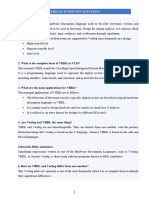Introduction to VerilogHDL_module_1_part2
Uploaded by
Mohammad Sania 22221882101Introduction to VerilogHDL_module_1_part2
Uploaded by
Mohammad Sania 22221882101Introduction to Verilog HDL
VLSI Design (Module I)
Y V Appa Rao
Department of Electrical, Electronics and Communication Engineering
GITAM Institute of Technology
GITAM University
2024-2025
Y V Appa Rao VLSI Design (Module I)
Introduction to Verilog HDL
Outline
1 Introduction to Verilog HDL
Verilog descriptions for Combinational logic
Y V Appa Rao VLSI Design (Module I)
Verilog descriptions for Combinational logic
Introduction to Verilog HDL
References
Introduction
Concurrency
HDLs use statements that execute concurrently since they
must model real hardware in which all the subsystems are in
operation at the same time
General-purpose computer languages can’t describe
concurrently operating hardware, as they are executed
sequentially
To model Combinational logic, it is essential to simulate the
execution of several parts of the circuit at the same
time-Concurrential execution
To model Sequential logic, it is necessary incorporate edge
sensitive ”always”block, to describe Synchronous behavior of
the circuit
Y V Appa Rao VLSI Design (Module I)
Verilog descriptions for Combinational logic
Introduction to Verilog HDL
References
Concurrent statements or Continuous assignments
Concurrent statements are always ready to execute
Evaluated any time and every time a signal on the RHS of the
statement changes
The order of the statements is not relevant for concurrential
execution
The signal assignment operator ”=”
”assign” statement is used to assign a value computed on the
right side to the signal on the left side
A signal declaration in Verilog usually corresponds to a signal
in a physical system
Y V Appa Rao VLSI Design (Module I)
Verilog descriptions for Combinational logic
Introduction to Verilog HDL
References
Concurrent statements or Continuous assignments
Interpretation of Continuous assignments by Verilog Simulator
Any time a signal on the RHS changes, the expression is
immediately reevaluated
Updates the signal on the LHS
Delays: Similar to the propagation delays associated with gates
and wires, delays in the continuous assignments are meaningful
The order of the statements is not important
The expression (on the RHS) is evaluated, and the signal on
the LHS is scheduled to change after the elapsement of the
delay
The delay is optional
Y V Appa Rao VLSI Design (Module I)
Verilog descriptions for Combinational logic
Introduction to Verilog HDL
References
Concurrent statements or Continuous assignments
Interpretation of Continuous assignments by Verilog Simulator
If the delay is omitted, the signal on the LHS will be updated
immediately
The time at which the statement executes and the time at
which the signal is updated are not the same if the delay is
specified
Even if a Verilog HDL program has no explicit loops,
concurrent statements execute repeatedly as if they were in a
loop
Contrast to VHDL, delta delays are not displayed for
continuous assignmnets in Verilog
Delta delay: It is an infinitesimally small delay used to
maintain sequnetiality detween dependent events happening at
the same time
Y V Appa Rao VLSI Design (Module I)
Verilog descriptions for Combinational logic
Introduction to Verilog HDL
References
Syntax for writing a valid Verilog description
Verilog is case sensitive: Upper-case and lower-case letters are
treated as different by the compiler and by the simulator
Identifiers: Contain letters, numbers, underscore character ( ),
and $ sign
An identifier must start with a letter or character, it can’t
start with a number or a $ sign
The $ sign is reserved as the first character for ”System tasks”
Every Verilog statement ends with a semicolon ( )
Y V Appa Rao VLSI Design (Module I)
Verilog descriptions for Combinational logic
Introduction to Verilog HDL
References
Syntax for writing a valid Verilog description
Spaces, tabs, carriage returns are treated in the same way
i.e., A Verilog statement can be written over several lines, or
several statements can be placed on one line
Wire (or net) type signals in Verilog, generally has a value of
0 or 1
The values on nets can be represented as binary, decimal, or
hexadecimal (b,d, and h)
Y V Appa Rao VLSI Design (Module I)
Verilog descriptions for Combinational logic
Introduction to Verilog HDL
References
Lexical conventions in Verilog
Vector: A 1-d array of bit signals is referred to as a vector,
e.g. 4-bit vector: wire [3:0] B; indicates a multiple bit wire
Array of gates: assign C = A & B; // bitwise ”AND” (&)
operator applied to two n-bit vectors ”A” and ”B”
Module in Verilog: A module in Verilog is a basic building
blocks that declares input, output signals and specifies the
operation of the digital system to be designed
Declaration of ”wire”: In Verilog internal signals are declared
as wire
Input/Output declaration part can be considered as the black
box picture of the module being designed and its external
interface
”inout”mode can be used for bi-directional signals
Y V Appa Rao VLSI Design (Module I)
Verilog descriptions for Combinational logic
Introduction to Verilog HDL
References
Lexical conventions in Verilog
Module instantiation: When we describe a digital system we
must specify input and output signals and also specify the
functionalities of the modules (instances) that are part of the
system
Each instance has a hierarchy of ports (port map): The
instance created has a one-to-one correspondence with the
signals in the actual module
This implies the order of the signals in the instantiated
module must be the same as the order of signals in the port of
the module declaration (Positional association)
Y V Appa Rao VLSI Design (Module I)
Verilog descriptions for Combinational logic
Introduction to Verilog HDL
References
Lexical conventions in Verilog
Testbench: To generate test patterns to be applied to the
device or circuit under test (DUT/CUT) for verifying the
functionality, or timing specifications
Except for the ”Test bench”, each module declaration
includes a list of interface signals that can be used to connect
to other modules or to the outside world
Order of precedence: Verilog does not specify an order of
precedence for logical operators except the ”NOT” operator
Y V Appa Rao VLSI Design (Module I)
Verilog descriptions for Combinational logic
Introduction to Verilog HDL
References
Lexical conventions in Verilog
Testbench: To generate test patterns to be applied to the
device or circuit under test (DUT/CUT) for verifying the
functionality, or timing specifications
Except for the ”Test bench”, each module declaration
includes a list of interface signals that can be used to connect
to other modules or to the outside world
Operators in Verilog include Logical, Bitwise, Arithmetic,
Concatenation and Conditional operators
Order of precedence for logical operators: Verilog does not
specify an order of precedence for logical operators except the
”NOT” operator
Y V Appa Rao VLSI Design (Module I)
Verilog descriptions for Combinational logic
Introduction to Verilog HDL
References
Verilog assignments
Two types of assignments in Verilog
(i) Continuous assignments: To assign values for various nodes
in Combinational logic circuits
Explicit continuous assignment: ”assign” keyword can be used
for the assignment after the net is separately declared
Implicit continuous assignment: The values is assigned in
declaration without using the keyword
(ii) Procedural assignments: Used to model registers and
Finite state machines (FSMs)
The keyword used: ”always”
Y V Appa Rao VLSI Design (Module I)
Verilog descriptions for Combinational logic
Introduction to Verilog HDL
References
References
Charles H. Roth, Lizy Kurian John, and Lee
Digital Systems design Using Verilog
Cengage Learning, 2016.
Douglas A. Pucknell, Kamran Eshraghian
Digital Systems design Using Verilog
Cengage Learning, 2016.
Y V Appa Rao VLSI Design (Module I)
You might also like
- Hardware Description Language Demystified: Explore Digital System Design Using Verilog HDL and VLSI Design ToolsFrom EverandHardware Description Language Demystified: Explore Digital System Design Using Verilog HDL and VLSI Design ToolsNo ratings yet
- Introduction to VerilogHDL Module 1 Part3 Procedural AssignmentsNo ratings yetIntroduction to VerilogHDL Module 1 Part3 Procedural Assignments11 pages
- System Design Through Verilog: Rakesh DasariNo ratings yetSystem Design Through Verilog: Rakesh Dasari92 pages
- (Ebook - PDF) Synthesizable Verilog-HDL Code - Circuit DesignNo ratings yet(Ebook - PDF) Synthesizable Verilog-HDL Code - Circuit Design63 pages
- Jaypee University of Engineering & Technology, Guna Deparment of Computer Science & EngineeringNo ratings yetJaypee University of Engineering & Technology, Guna Deparment of Computer Science & Engineering7 pages
- Hardware Description Language or HDL Is Any Language From A Class ofNo ratings yetHardware Description Language or HDL Is Any Language From A Class of11 pages
- Chap10_Logic Synthesis with Verilog HDLNo ratings yetChap10_Logic Synthesis with Verilog HDL12 pages
- Chapter-1: 1.1. Serial Data TransmissionNo ratings yetChapter-1: 1.1. Serial Data Transmission44 pages
- Hardware Description Languages and Programmable LogicNo ratings yetHardware Description Languages and Programmable Logic40 pages
- Digital System Modelling Using Hardware Description Language (HDL)No ratings yetDigital System Modelling Using Hardware Description Language (HDL)56 pages
- (System) Verilog To Chisel Translation For Faster Hardware DesignNo ratings yet(System) Verilog To Chisel Translation For Faster Hardware Design7 pages
- VHDL - Intro and Syntax - VLSI Design Using VHDL Training - Internshala VTCNo ratings yetVHDL - Intro and Syntax - VLSI Design Using VHDL Training - Internshala VTC2 pages
- VHDL Code For Full Subtractor Using Behavioral Method - Full Code & ExplanationNo ratings yetVHDL Code For Full Subtractor Using Behavioral Method - Full Code & Explanation8 pages
- Module - 5 Introduction To VHDL 5.1: ObjectivesNo ratings yetModule - 5 Introduction To VHDL 5.1: Objectives14 pages
- Lexicon of Programming Terminology: Lexicon of Tech and Business, #17From EverandLexicon of Programming Terminology: Lexicon of Tech and Business, #175/5 (1)
- WAN TECHNOLOGY FRAME-RELAY: An Expert's Handbook of Navigating Frame Relay NetworksFrom EverandWAN TECHNOLOGY FRAME-RELAY: An Expert's Handbook of Navigating Frame Relay NetworksNo ratings yet
- Relational Database Index Design and the Optimizers: DB2, Oracle, SQL Server, et al.From EverandRelational Database Index Design and the Optimizers: DB2, Oracle, SQL Server, et al.5/5 (1)
- Day 2 Python Data Structure and FunctionsNo ratings yetDay 2 Python Data Structure and Functions4 pages
- ANNU, BBA (GEN), 04721201719, ISM LAB (1) - CompressedNo ratings yetANNU, BBA (GEN), 04721201719, ISM LAB (1) - Compressed43 pages
- Practical File: Database Management SystemNo ratings yetPractical File: Database Management System27 pages
- Tutorial Letter 201/1/2012: Introduction To Programming II Semester 1No ratings yetTutorial Letter 201/1/2012: Introduction To Programming II Semester 121 pages
- Top 50 System Design Interview Questions for 2024No ratings yetTop 50 System Design Interview Questions for 202415 pages
- DC Coding and Decoding With Convolutional CodesNo ratings yetDC Coding and Decoding With Convolutional Codes28 pages
- 12computer Science-Python Libraries and Idea of Efficiency-NotesNo ratings yet12computer Science-Python Libraries and Idea of Efficiency-Notes14 pages
- Delhi Public School: Electricity Billing SystemNo ratings yetDelhi Public School: Electricity Billing System29 pages
- Drag and Drop With List Box - Visual Basic 6 (VB6No ratings yetDrag and Drop With List Box - Visual Basic 6 (VB64 pages
- Hardware Description Language Demystified: Explore Digital System Design Using Verilog HDL and VLSI Design ToolsFrom EverandHardware Description Language Demystified: Explore Digital System Design Using Verilog HDL and VLSI Design Tools
- Introduction to VerilogHDL Module 1 Part3 Procedural AssignmentsIntroduction to VerilogHDL Module 1 Part3 Procedural Assignments
- (Ebook - PDF) Synthesizable Verilog-HDL Code - Circuit Design(Ebook - PDF) Synthesizable Verilog-HDL Code - Circuit Design
- Jaypee University of Engineering & Technology, Guna Deparment of Computer Science & EngineeringJaypee University of Engineering & Technology, Guna Deparment of Computer Science & Engineering
- Hardware Description Language or HDL Is Any Language From A Class ofHardware Description Language or HDL Is Any Language From A Class of
- Hardware Description Languages and Programmable LogicHardware Description Languages and Programmable Logic
- Digital System Modelling Using Hardware Description Language (HDL)Digital System Modelling Using Hardware Description Language (HDL)
- (System) Verilog To Chisel Translation For Faster Hardware Design(System) Verilog To Chisel Translation For Faster Hardware Design
- VHDL - Intro and Syntax - VLSI Design Using VHDL Training - Internshala VTCVHDL - Intro and Syntax - VLSI Design Using VHDL Training - Internshala VTC
- VHDL Code For Full Subtractor Using Behavioral Method - Full Code & ExplanationVHDL Code For Full Subtractor Using Behavioral Method - Full Code & Explanation
- ORACLE PL/SQL Interview Questions You'll Most Likely Be AskedFrom EverandORACLE PL/SQL Interview Questions You'll Most Likely Be Asked
- Lexicon of Programming Terminology: Lexicon of Tech and Business, #17From EverandLexicon of Programming Terminology: Lexicon of Tech and Business, #17
- WAN TECHNOLOGY FRAME-RELAY: An Expert's Handbook of Navigating Frame Relay NetworksFrom EverandWAN TECHNOLOGY FRAME-RELAY: An Expert's Handbook of Navigating Frame Relay Networks
- Introduction To Logic Circuit Design With VHDLFrom EverandIntroduction To Logic Circuit Design With VHDL
- Relational Database Index Design and the Optimizers: DB2, Oracle, SQL Server, et al.From EverandRelational Database Index Design and the Optimizers: DB2, Oracle, SQL Server, et al.
- ANNU, BBA (GEN), 04721201719, ISM LAB (1) - CompressedANNU, BBA (GEN), 04721201719, ISM LAB (1) - Compressed
- Tutorial Letter 201/1/2012: Introduction To Programming II Semester 1Tutorial Letter 201/1/2012: Introduction To Programming II Semester 1
- 12computer Science-Python Libraries and Idea of Efficiency-Notes12computer Science-Python Libraries and Idea of Efficiency-Notes





























































































